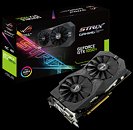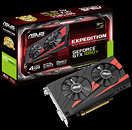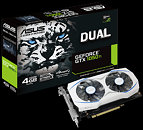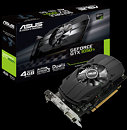Wednesday, October 19th 2016

ASUS Announces its GeForce GTX 1050 Series
ASUS today announced the Republic of Gamers (ROG) Strix GeForce GTX 1050 Ti and Strix GeForce GTX 1050, all-new gaming graphics cards powered by the NVIDIA GeForce GTX 1050 Ti and GeForce GTX 1050 graphics processing units (GPUs) that deliver ultra-fast performance, advanced cooling and reliability, and ASUS Aura Sync technology for personalized styling.
Also announced were the ASUS Expedition, Dual, and Phoenix series, three all-new graphics cards series powered by the latest NVIDIA GeForce GTX 1050 Ti and GeForce GTX 1050 GPUs that give gamers a range of options for building the perfect gaming PC. Expedition series graphics cards are built for non-stop gaming action with extra-durable designs. Dual series cards feature color themes that perfectly match ASUS Z170-A and Z170-PRO motherboards, making them easy to design and build a great-looking PC. Phoenix series cards feature compact designs, making them the ideal choice for smaller gaming PCs. ASUS Expedition, Dual, and Phoenix series graphics cards' low power consumption when run at stock clock speed keeps them below the 75W power limit provided by PCI Express (PCIe) expansion slots. All power to the graphics cards is delivered by the slot, with no need for an auxiliary connection to the power supply.ASUS graphics cards are produced using Auto-Extreme technology - an industry-first 100 percent-automated production process - and are built using premium Super Alloy Power II components that enhance efficiency, reduce power loss, decrease component buzzing under load, and lower thermal temperatures for unsurpassed quality and reliability. They also include GPU Tweak II for intuitive performance tweaking. With one click, the Gaming Booster function maximizes system performance by removing redundant processes and allocating all available resources automatically. An included 14-day XSplit Gamecaster premium license lets gamers easily stream or record gameplay via a convenient, in-game overlay. The overlay also displays GPU clock speed, temperature, and VRM usage, and has GPU Tweak II controls, so gamers can choose a gaming profile and boost performance with just one click.
ROG Strix series: Cooling performance, reliability, and style
ROG Strix GeForce GTX 1050 Ti and ROG Strix GeForce GTX 1050 are packed with exclusive ASUS technologies, including DirectCU II with a patented dual wing-blade 0dB fan designed to deliver maximum airflow for 30 percent-cooler and three-times (3X) quieter performance, and ASUS FanConnect, which features a GPU-controlled fan header to connect to a system fan for targeted supplemental cooling.
ROG Strix GeForce GTX 1050 Ti and ROG Strix GeForce GTX 1050 feature ASUS Aura Sync, RGB LED synchronization technology that enables complete gaming system personalization when the graphics card is paired with an Aura-enabled gaming motherboard.
Expedition series: Built for non-stop gaming action
ASUS Expedition GeForce GTX 1050 Ti and Expedition GeForce GTX 1050 feature durable designs for enhanced reliability, making them the perfect choice for heavily used gaming systems. Both graphics cards come with a dual-ball-bearing fan that eliminates the problem of oil drying found in sleeve-bearing fans, resulting in 2X-longer lifespans. With reduced friction, they also run smoother, further improving card lifespan and cooling efficiency.
ASUS operates the iCafé Lab, a testing environment that simulates the unique and demanding conditions found in internet cafés. Expedition GeForce GTX 1050 Ti and Expedition GeForce GTX 1050 each passed 144 hours of dedicated iCafe Lab tests - including a two-hour reboot test and 15-hour 3D Mark test with heavy loading - certifying them for use as a diskless systems and ensuring they are ready for non-stop gaming performance. ASUS iCafé Lab engineers also subjected Expedition series graphics cards to lengthy stability tests with the most popular games to ensure they deliver the very best gaming experiences.
Dual series: Matching color themes for unique PC builds
ASUS Dual GeForce GTX 1050 Ti and Dual GeForce GTX 1050 graphics cards share perfectly matching color themes with ASUS Z170-A and Z170-PRO motherboards, making it easy for users to design and build a great-looking system. Dual series cards are fully compatible with Windows 10 and are also equipped with DirectX 12 to squeeze more graphics performance from the CPU and prevent GPU bottlenecks.
Dual GeForce GTX 1050 Ti and Dual GeForce GTX 1050 provide 'sweet spot' graphics performance that is ideal for eSports gaming. With optimized dual fans, Dual series graphics cards deliver 2X-greater airflow than reference cards for enhanced cooling performance and a more pleasant gaming and computing environment.
Phoenix series: Compact designs for smaller builds and 2X-longer lifespans
ASUS Phoenix GeForce GTX 1050 Ti and Phoenix GeForce GTX 1050 feature compact designs that makes them the perfect fit for smaller gaming PCs. Phoenix series graphics cards come with a dual-ball-bearing fan that eliminates the problem of oil drying found in sleeve-bearing fans, resulting in 2X-longer lifespans. With reduced friction, they also run smoother, further improving card lifespan and cooling efficiency.
Also announced were the ASUS Expedition, Dual, and Phoenix series, three all-new graphics cards series powered by the latest NVIDIA GeForce GTX 1050 Ti and GeForce GTX 1050 GPUs that give gamers a range of options for building the perfect gaming PC. Expedition series graphics cards are built for non-stop gaming action with extra-durable designs. Dual series cards feature color themes that perfectly match ASUS Z170-A and Z170-PRO motherboards, making them easy to design and build a great-looking PC. Phoenix series cards feature compact designs, making them the ideal choice for smaller gaming PCs. ASUS Expedition, Dual, and Phoenix series graphics cards' low power consumption when run at stock clock speed keeps them below the 75W power limit provided by PCI Express (PCIe) expansion slots. All power to the graphics cards is delivered by the slot, with no need for an auxiliary connection to the power supply.ASUS graphics cards are produced using Auto-Extreme technology - an industry-first 100 percent-automated production process - and are built using premium Super Alloy Power II components that enhance efficiency, reduce power loss, decrease component buzzing under load, and lower thermal temperatures for unsurpassed quality and reliability. They also include GPU Tweak II for intuitive performance tweaking. With one click, the Gaming Booster function maximizes system performance by removing redundant processes and allocating all available resources automatically. An included 14-day XSplit Gamecaster premium license lets gamers easily stream or record gameplay via a convenient, in-game overlay. The overlay also displays GPU clock speed, temperature, and VRM usage, and has GPU Tweak II controls, so gamers can choose a gaming profile and boost performance with just one click.
ROG Strix series: Cooling performance, reliability, and style
ROG Strix GeForce GTX 1050 Ti and ROG Strix GeForce GTX 1050 are packed with exclusive ASUS technologies, including DirectCU II with a patented dual wing-blade 0dB fan designed to deliver maximum airflow for 30 percent-cooler and three-times (3X) quieter performance, and ASUS FanConnect, which features a GPU-controlled fan header to connect to a system fan for targeted supplemental cooling.
ROG Strix GeForce GTX 1050 Ti and ROG Strix GeForce GTX 1050 feature ASUS Aura Sync, RGB LED synchronization technology that enables complete gaming system personalization when the graphics card is paired with an Aura-enabled gaming motherboard.
Expedition series: Built for non-stop gaming action
ASUS Expedition GeForce GTX 1050 Ti and Expedition GeForce GTX 1050 feature durable designs for enhanced reliability, making them the perfect choice for heavily used gaming systems. Both graphics cards come with a dual-ball-bearing fan that eliminates the problem of oil drying found in sleeve-bearing fans, resulting in 2X-longer lifespans. With reduced friction, they also run smoother, further improving card lifespan and cooling efficiency.
ASUS operates the iCafé Lab, a testing environment that simulates the unique and demanding conditions found in internet cafés. Expedition GeForce GTX 1050 Ti and Expedition GeForce GTX 1050 each passed 144 hours of dedicated iCafe Lab tests - including a two-hour reboot test and 15-hour 3D Mark test with heavy loading - certifying them for use as a diskless systems and ensuring they are ready for non-stop gaming performance. ASUS iCafé Lab engineers also subjected Expedition series graphics cards to lengthy stability tests with the most popular games to ensure they deliver the very best gaming experiences.
Dual series: Matching color themes for unique PC builds
ASUS Dual GeForce GTX 1050 Ti and Dual GeForce GTX 1050 graphics cards share perfectly matching color themes with ASUS Z170-A and Z170-PRO motherboards, making it easy for users to design and build a great-looking system. Dual series cards are fully compatible with Windows 10 and are also equipped with DirectX 12 to squeeze more graphics performance from the CPU and prevent GPU bottlenecks.
Dual GeForce GTX 1050 Ti and Dual GeForce GTX 1050 provide 'sweet spot' graphics performance that is ideal for eSports gaming. With optimized dual fans, Dual series graphics cards deliver 2X-greater airflow than reference cards for enhanced cooling performance and a more pleasant gaming and computing environment.
Phoenix series: Compact designs for smaller builds and 2X-longer lifespans
ASUS Phoenix GeForce GTX 1050 Ti and Phoenix GeForce GTX 1050 feature compact designs that makes them the perfect fit for smaller gaming PCs. Phoenix series graphics cards come with a dual-ball-bearing fan that eliminates the problem of oil drying found in sleeve-bearing fans, resulting in 2X-longer lifespans. With reduced friction, they also run smoother, further improving card lifespan and cooling efficiency.




6 Comments on ASUS Announces its GeForce GTX 1050 Series